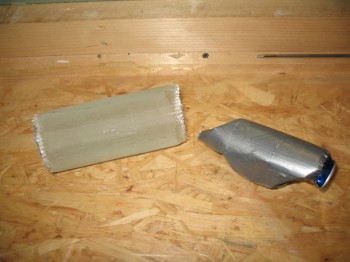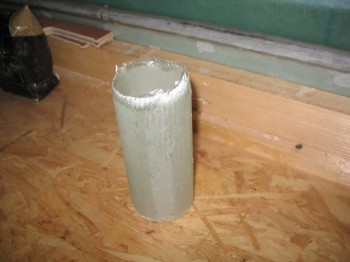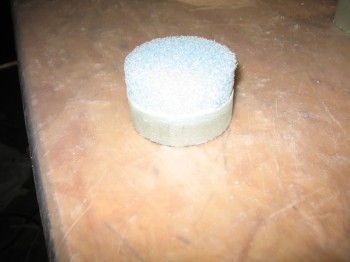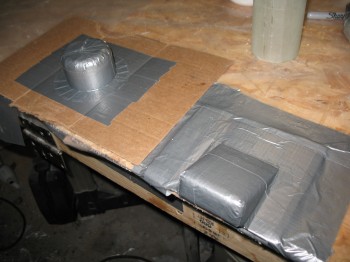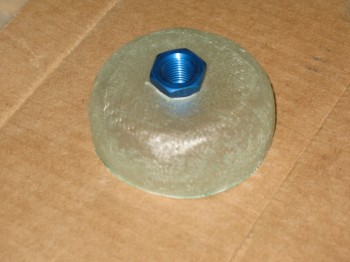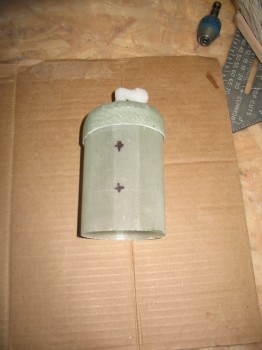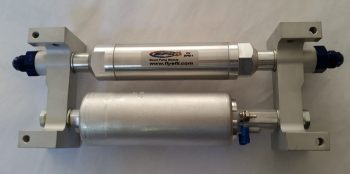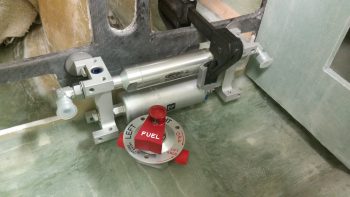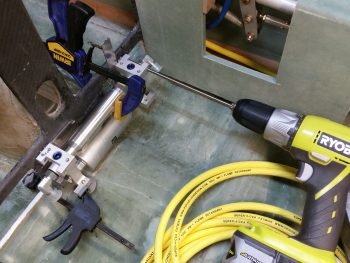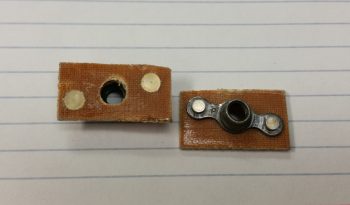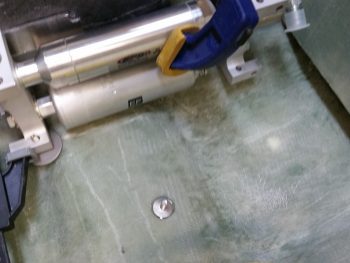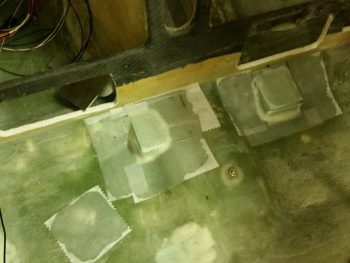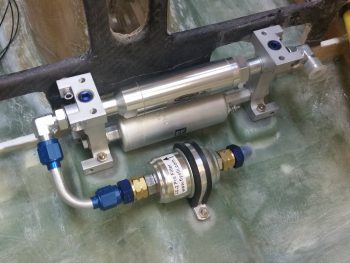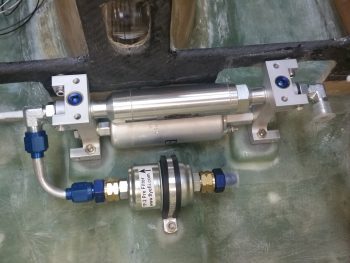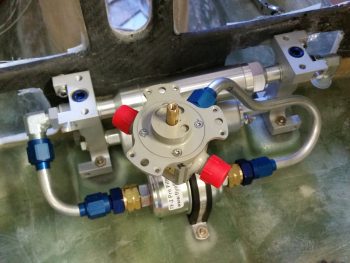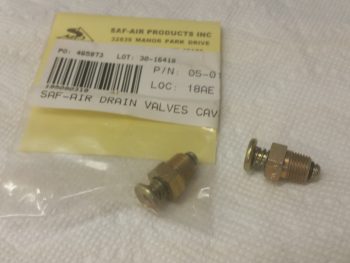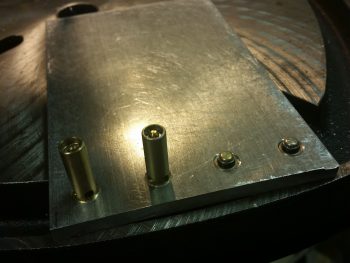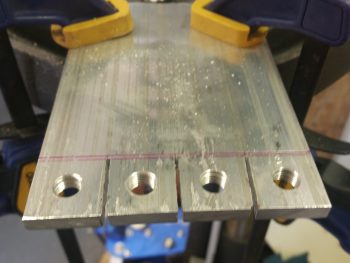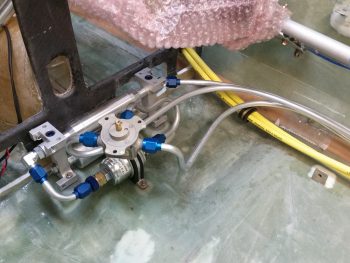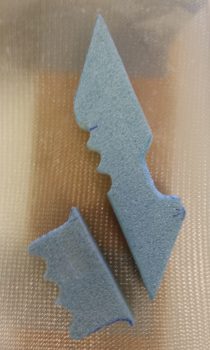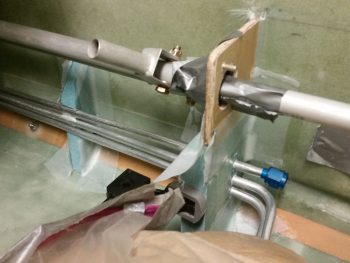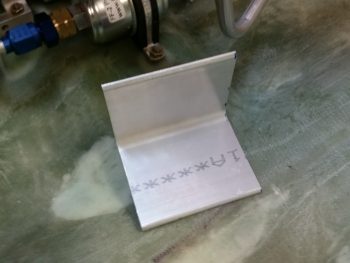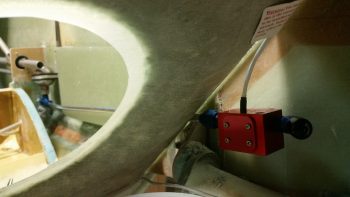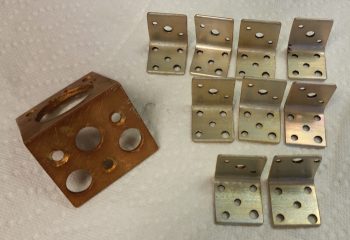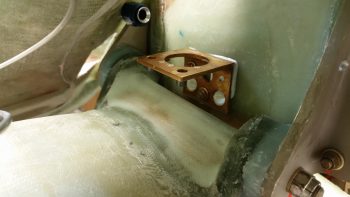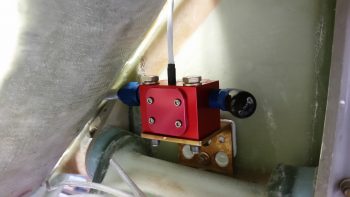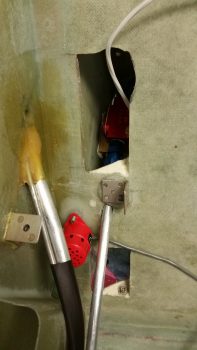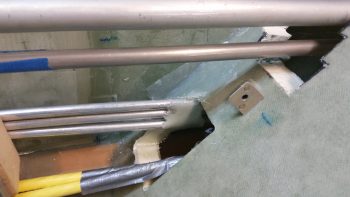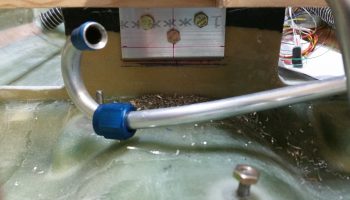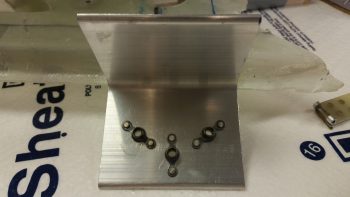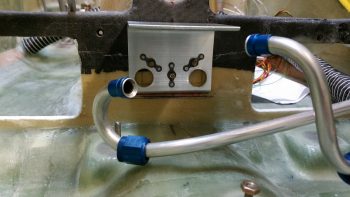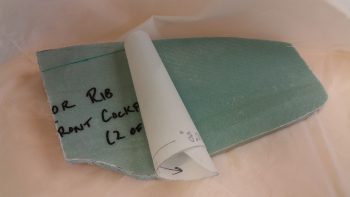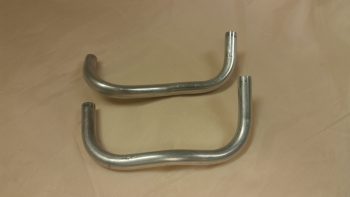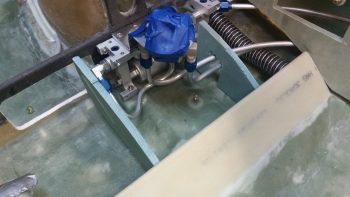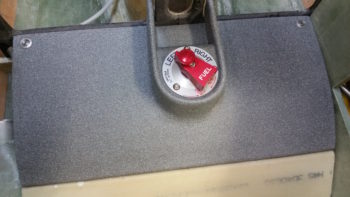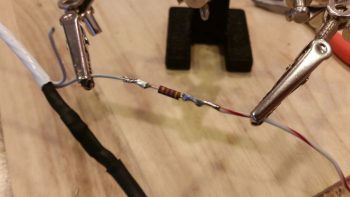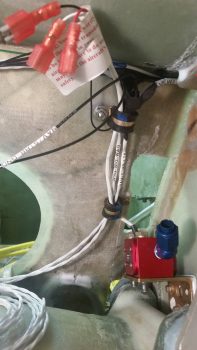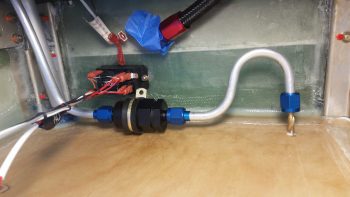Chapter 21 – Strakes & Fuel System
May 2012 — After a back & forth discussion with a builder that decided he wasn’t going to use these caps anymore, I bought these Newton fuel caps on Ebay.
These are the locking style caps as you can see in the pic below.
I was looking for the Newton A36LFF style caps with the solid flange vs. the flange that has bolt holes around the perimeter for attachment. I believe these are slightly different than the A36LFF in that the flanges on these are simply sans holes, while if I’m correct the actual A36LFF has a raised lip around the cap and a slightly lower flange to allow it to be glassed in place.
Below is a shot of the interior side of the fuel cap.
And a shot of the retaining flange, underside.
I definitely remember for the price that I would make this configuration work since the pair of these caps were way less than buying just one A36LFF cap from ACS! Plus, the flange showing on the external fuel tank surface versus just the cap peeking out is much more visually appealing to me. I understand the issues of securing it, and I have an idea or two that will keep these guys in place.
One cap does have a couple of very light scratches (which I believe will happen over time anyway) and I’ll make a point that while these have a goldish appearance in all these pics (from the original seller) they in fact have the normal fuel cap silver aluminum finish.
[Admin Note: I got a note from fellow Long-EZ builder Brian Ashton from Alaska asking a question about my fuel caps that I mentioned in my April 2015 post on acquiring fuel cap keys from ACS for these caps. Well, to answer Brian’s question I had to go back and do a bit of research on my own fuel caps. Turns out, I was remiss in ever actually posting anything about my fuel caps, so I am doing that here to correct my oversight! Thanks Brian!]
•••
3 October 2012 — Below is the EFII Electric Fuel Boost Pump with filters that I recently received from ACS.
•••
18 October 2012 — I thought I would show a picture of the fuel blisters that I just recently received from Feather Light. I’ll be real happy when I’m posting pictures of these guys installed!
[Operational Note: I did NOT end up using the fuel sump blisters above. Since I have the Mike Melvill Carbon Fiber cowlings that incorporate the Berkut-style “armpit” cooling intakes, I did not want these fuel sump blisters mounted immediately in front of the intakes and causing significant disruption to my engine cooling air. I instead mounted the sumps in the GIB thigh support (see ‘Internal GIB thigh support fuel sump tanks’ page).]
•••
16 May 2013 — I researched & ordered my AN fuel line fittings.
•••
21 May 2013 — Although my primary focus today was to get both Inboard sides of the NG30s glassed, I like to multitask whenever possible. In the pics below I’m sure you’ll note the Rock Star energy drink can covered with duct tape. I glassed it with a 2-ply BID layup immediately following the NG30 layups, and then of course peel plied it.
This can is the start to the makings of a fuel tank vent manifold as James Redmon did on his fantastic Berkut 13. James has an awesome site covering his Berkut build at www.berkut13.com, and for details on the fuel tank vent manifold system click here. Below are also some before and after closeup shots of the can as it was glassed/peel plied.
Since I laid up the fuel tank vent manifold 2-ply BID layup with fast hardener, just a couple hours later I pulled the peel ply.
[Operational Note: Unfortunately I will NOT be using this fuel vent manifold since I will be using a left & right sumped system (as per plans, minus the internal sumps) and NOT a no-management fuel system. I will thus have 2 vents per tank that exit each tank, travel along the top edge of the firewall and then exit out the bottom of the aircraft on each side near the bottom of each strake.]
•••
22 May 2013 — I removed the can from the fuel tank vent manifold body.
•••
27 May 2013 — I started off by marking & cutting the ragged ends off the fuel tank vent manifold body (that I glassed around a Rock Star energy drink can).
I then used one of the cut end pieces to make a form for the fuel vent manifold end cap using blue wing foam.
After I formed the shape I was looking for, I covered the entire form with duct tape & then fastened it using the tape to a duct tape base on a piece of cardboard.
The pics below show the form ready for the 2-ply BID layup.
And here’s the cap curing in front of the heater (it was quite chilly weather in Germany even though it was late May).
Since I used all fast hardener on these components, I think the much faster curing sealed the glassed pieces to the foam more than usual. The first fuel tank vent manifold cap I made was a bear to get off the form, and I ended up tearing up the somewhat fragile foam form to get it off the darn thing. Thus, I had to make a completely new form for the second fuel tank vent manifold cap. No worries. Also, when I was glassing the 2-ply BID layup, some of the plies separated at the “corner” of the cap. Instead of messing around with pulling the separated ply, I simply added another ply of BID for 3-plies total on the second cap.
After I got the second fuel tank vent manifold cap laid up & curing, I then mocked up the first cap to see how it fit. Once I saw that the fit was good I drilled a ~21/64″ hole (I had to use my Perma-Grit tool once I drilled the initial hole so the measurement is an approximate…forgive me Marco for not pulling out the calipers!) and mocked up the AN912 bushing & Nylaseal adapter.
Once I confirmed that AN bushing fit well, I sanded/prepped around the hole on the cap and floxed the bushing into place.
[Operational Note: Unfortunately I will NOT be using this fuel vent manifold since I will be using a left & right sumped system (as per plans, minus the internal sumps) and NOT a no-management fuel system. I will thus have 2 vents per tank that exit each tank, travel along the top edge of the firewall and then exit out the bottom of the aircraft on each side near the bottom of each strake.]
•••
28 May 2013 — I pulled the fuel tank vent manifold end cap from its form, cut off the excess material & then sanded it. Below are the pics showing the manifold in its first ever appearance as one component.
•••
5 June 2013 — First off, the pic below shows my Andair fuel valve.
On the fuel tank vent manifold I drilled a hole in the top (again, about 21/64″ in diameter) of the second cap & then test fitted the AN912 bushing.
I then marked the first 2 (out of 4) side positions & drilled those holes as well.
I then test fitted the two AN912 bushings into the side of the manifold, placed the new end cap in place and prepped all of the bushings & glass for floxing.
I floxed in 2 AN912 bushings into the side of the manifold & floxed one AN912 bushing into the cap. I set them in front of the heater to cure.
•••
6 June 2013 — I mocked up my Chapter 21 – Fuel Tank Vent Manifold parts and still have 2 more side bushings yet to install.
•••
8 June 2013 — I used the remaining amount of epoxy from the winglet layups to mix up a batch of flox to install the the final 2 each AN912 bushings into my fuel vent manifold body. After I floxed them in, I set the manifold body in front of the heater to cure (the heater it’s leaning against is obviously not the heater being used).
•••
12 June 2013 — When I mixed up the flox for the installing the Davenport leaf spring attach tube, I made up enough to also flox one of the Fuel Vent Manifold end caps into place. I prepped the glass surfaces to be bonded by sanding the external top of the manifold body & the inside edge of the cap. Below is the Fuel Vent Manifold end cap being floxed permanently to the cylindrical manifold body (I’ll blame the blurry pics on my camera being tempermental).
[Operational Note: Unfortunately I will NOT be using this fuel vent manifold since I will be using a left & right sumped system (as per plans, minus the internal sumps) and NOT a no-management fuel system. I will thus have 2 vents per tank that exit each tank, travel along the top edge of the firewall and then exit out the bottom of the aircraft on each side near the bottom of each strake.]
•••
7 April 2015 — Today I got some important keys. One set, the cam lock & keys, is a recent requirement and is for the headrest opening, while the other has been on my list to acquire since 2012, which are the keys for the Newton fuel caps that I bought back then.
The two sets of keys on the right are the keys to the Newton fuel caps. At this time, these are a special order item if you want to purchase them through Aircraft Spruce.
•••
29 June 2016 — I finally knocked another item off my list by giving the folks at EFII a call to order a couple of 90° fittings. Unlike standard right angle fittings, these 90° fittings supplied by EFII can be clocked into any orientation so the exact angle of the connected fuel lines can be dialed in.
I need these right-angle fittings since I’ll be placing the fuel pump in the hell hole mounted on the underside of the CS spar. The awesome folks at EFII quickly sent me out a pair of the 90° fittings with the only requirement that I send back the stock straight fittings.
Here’s my newly configured fuel pump, now ready for install!
•••
8 September 2016 — Today I started off by calling the folks at EFII to query them on my options for mounting my EFII fuel pump. In my research on fuel pumps, the position of the pump in relation to the fuel IN feed line is important, with a general requirement that the fuel pump be situated at a lower point than the IN fuel feed. Since I was thinking about mounting the fuel pump directly to the bottom of the CS Spar in the hell hole, I wanted to make sure I could do this without violating any conventional wisdom mandates. Well, as it turns out –and this is directly from the EFII horse’s mouth– it doesn’t matter the elevation of the pump vs the feed line, as long the pump is mounted horizontally. Still, after taking the pump down to the shop and mocking it up in a few locations, I decided the hell hole was going to be a crowded place, both in components making their residence there and with all the transient elements (fuel lines, cable antennas, wiring, cables, etc.) coming and going, let alone the exact space required for my RAM air intake. So I decided to kick this fuel pump can down the road and wait until I get closer to HAVING to install it.
•••
26 October 2016 — I started off today with something I was curious about, and wanted to answer a nagging question that I’ve been having: will the EFII fuel pump fit under the pilot seat thigh support? In line with what I posted above, I’ve seen a number of builders place the fuel pump up front near the fuel valve. This is good for a few different reasons: 1) ease of maintenance, 2) direct knowledge –due to the noise/vibration– of whether its on or off, and arguably the most important reason, 3) is it drives 2-1/2 lbs of weight farther forward in the fuselage.
So, since I wanted to see where a good location was for the fuel pump, and in relation to the fuel valve, I played around with a few different mounting locations. I stopped at this one since I really like that the pump can be mounted vertically here, thus driving as much of the pump weight forward as practically possible. It also gives some nice space for the fuel valve and the fuel lines.
•••
11 May 2017 — Today I started out doing some planning and inventorying for my fuel system. Since I’m going to make my new work demarcation line at the pilot’s seat bulkhead, going forward, then I needed to figure out my fuel system in real terms, not just in my head. I drew out the fuel system on a white board and then did an inventory to see what I had on hand and to see what I needed to order. I was fairly pleased that I had the majority of stuff I needed on hand, but will need to order about $35 in fittings from ACS.
I also did some research on the exact installation requirements for each fuel system component. For example, on the Andair fuel valve I could clearly see that the big red selector handle needed to come off to install it, but I hadn’t even truly read the install manual until today to find out how to remove the handle, and install the unit. I also had some questions on the FT-60 Red Cube fuel flow sensor that I eventually got answered on the VAF site. In addition, I wanted to double check some info on the fuel pump.
After a few hours I was happy with my progress on the fuel system and was satisfied that I actually knew the direction I was headed with that system once again.
•••
12 May 2017 — Today I focused on mounting the EFII fuel pump and its pre-filter. I played around with the configuration for a bit before finally narrowing both components’ locations as shown below.
With the existing fillet at the bottom aft of the instrument panel –where it’s glassed to the fuselage floor pan– I needed to have a slight gap between the fuel body and the instrument panel. I thought 1/16″ (0.063″) would do it at first, but it wasn’t enough and still caused the bottom of the fuel pump to kick out aft a little bit, not allowing for a true vertical install. I tried 1/8″ (0.125″) but it seemed a bit too much. I then scrounged up some 0.093″ scrap aluminum to test as a spacer and that did the trick.
With the position of fuel pump dialed into its final position, I clamped it and drilled the top 2 mounting holes into the lower instrument panel.
I then made up 2 K1000-3 nutplate assemblies with 1/16″ phenolic.
With my fuel pump positioned, I then fiddled around with the pre-filter before I finally figured out its final position. I then marked the spot and 5-min glued a click bond in position (after I prepped the clickbond).
I then laid up 3-plies of BID over the Clickbond after creating a flox transition around its edges.
I also floxed in the left nutplate assembly and screwed an AN3 bolt into it to hold tightly in place while it cured. Over on the right side, due to the drilled mounting hole being so low on the lower instrument panel cross frame (top edge of map box/lower edge of leg opening) I micro’d in a half moon looking piece of H45 foam in prep for 2 plies of BID on the front side, and 1 on the aft side.
If you’re wondering about the bolt head’s close proximity to the fuel pump frame, and how it can’t possibly turn, you’ve spotted an issue. Tomorrow I need to pick up some hex head socket cap screws to allow them to turn in tight quarters.
I then decided it was time to roll up my sleeves and knock out the hour++ trial and error process of forming respective Devinycell wedges for both the right and left side of the fuel pump. As you can see, these foam pieces will make up the mounting pads for the fuel pump frame’s “feet,” allowing me to bolt in the fuel pump frame on the lower aft sides (vertical bolts) and the forward side (left & right as well) using horizontal bolts.
After mocking up the fuel pump countless times, with a myriad of sanding with my Perma-Grit tools (still love those things!) to shape the respective pads, I finally got the shape and positioning I wanted with the pads. Moreover, with the pads in place and the fuel pump temporarily installed, I could checked that there was a decent gap for the eventual mounting of the bigger sized click bonds for the aft side fuel pump mounting.
I then micro’d the foam pads in place and laid up 2 plies of BID over each pad. Down in the lower left corner in the pic below is a small square ply of BID that I glassed in placed and peel plied (along with the pad layups) to patch a small divot I had put in the floor at some point… I still had a small amount of epoxy left over allowing me to do this.
I also floxed the right mounting nut plate assembly into place (after I redrilled the hole) and held it in place with an AN3 bolt while it cured.
Below you can see a shot of the small curved piece of foam I glassed in place to help as a backer for the the right side fuel pumping mounting nutplate assembly.
With that, I did one final check on all the layups, and called it a night.
•••
13 May 2017 — First thing this morning I pulled the peel ply off the fuel pump mounting pads. There were a couple minor air bubbles but the layups looked good. I cleaned up the peel ply strings a little before snapping this shot.
And then sanded the areas that I couldn’t easily apply peel ply to last night.
I then quickly checked the fuel pump fit on the mounting pads.
I then prepped & floxed the 2 larger click bonds in place onto the mounting pads, securing the fuel pump in its mounting position to keep the click bonds appropriately spaced.
I ran over to visit my EAA buddy when I also stopped by my local Village Hardware store to pick up some 1-1/4″ SS hex drive cap head screws. Normally stores only have half-inch increments available after 1″ (then 1-1/2″, 2″, 2-1/2″, etc.) but behind all the other cap head screws they had a small box: 1-1/4″ length for apparently a previous special order! Voila! And they didn’t even have a price… but we worked out a price and I bought a couple and was on my way to Jeff’s in short order.
Upon returning from Jeff’s a few hours later, I then cleaned up & prepped the 2 large fuel pump mounting click bonds for glass.
After adding a bit of flox for transition around the edge of each click bond, I then laid up 3 plies of BID over each one. I peel plied the 2 layups and then took off to meet a buddy of mine for dinner and a movie (sorry, no pic of the peel ply on the layups).
Upon returning home for the evening I pulled the peel ply and cleaned up the layups.
I then test fitted the fuel pump mounting on the freshly installed lower click bonds on my glassed foam mounting pads. Looking good! One small issue that I have is that the 1-1/4″ bolts are too long to fit in the gap on the fuel pump mounting frame. I’ll have to drill out the aft-side mounting holes –which aren’t used here– to a wider diameter to allow the bolt head to fit and slide through to the other (forward) side.
I then test mounted the fuel pump’s pre-filter to check its fit & placement. Again, looking good so far!
•••
14 May 2017 — Tonight I started out by drilling out the front side mounting holes on the fuel pump to 5/16″ diameter to allow me to slide the hex head cap screw through the front to then hold the fuel pump in place.
After drilling the front side of the fuel pump frame for the 2 top side mounting screws, I mounted the fuel pump . . . officially for the first time!
Here’s a close up of the hex head cap screw/bolt securing the top of the fuel pump in place. As you can see, I still need to micro & glass the nutplate assemblies into place.
Here’s a shot of the aft left side mounting hole that I drilled out to 5/16″ & tapered with a large 3/4″ countersunk bit for ease of getting the mounting bolt inserted.
I wanted to ensure that all the pieces of my fuel hobby project here would fit together, so I cut a 3″ piece of 3/8″ 3003-0 aluminum fuel line tubing and collected up some fittings to connect the fuel pre-filter OUT to the fuel pump IN line.
With such a small piece space in the flaring & bending tools were TIGHT, but as you can see I was able to get the flares made & tubing bent to connect the pre-filter to the fuel pump.
Here’s another shot after I rotated the tubing downward about another 1/2″.
Also tonight I wanted to get one more major task completed tonight: run the fuel line from the Andair fuel valve OUT port to the EFII fuel pump pre-filter IN port.
In reality, this task was a 2 part process. I ended up nearly destroying the first piece of tubing I tried to install here, but then ended up using it as a prototype model to then craft the second tubing with the tubing bender vs. my ham-fisted manipulations of the tubing. I figure this will the be the most difficult fuel line tubing connection that I’ll have to make on my fuel system.
Beside just getting this tubing piece configured and in place, my actual main goal here was to figure out the positioning of the Andair fuel valve. As per my norm, you’d probably not be surprised to learn that I am NOT putting this valve in the plans position! Close, but it will sit over an inch higher and well aft of the plans position.
Why? Well, in talking to current Long-EZ flyers, and having sat in Marco’s Long-EZ, I can tell you with all certainty that I want to have the ability to SEE what position my fuel selector is set on versus only being able to FEEL the position of my fuel selector valve. I will of course check this out and ensure I have enough seating room, but beyond any other issues, this is my main goal as far as the fuel valve configuration & installation is concerned.
•••
15 May 2017 — Today, with the leftover epoxy I had from glassing over the pitch trim mount, I added a little more to the bit of flocro I had and made primarily a micro mix. I spread the micro on both the left & right side nutplate assemblies used to secure the upper fuel pump attach bolts in place. I then laid up 1 ply of scrap BID over each of the nutplate assemblies and peel plied the BID.
Then, while the composite stuff cured, I set my sights back onto the Andair fuel selector valve. I took the valve lever and cover off to assess how it will get mounted to the fuel valve bracket & cover. I also wanted to double-check that the K1000-3 nutplate mounting holes were countersunk for the rivets, which they were.
I then riveted 3 each K1000-3 nutplates to the Andair fuel selector valve.
I set the fuel selector valve back in place and will assess it more fully later on.
Here are both the left & right side nutplate assemblies used to secure the upper fuel pump attach bolts after their layups cured. I realize it looks like a lot of micro is covering these nutplate assemblies, but there really isn’t that much. The thickness of the phenolic combined with the back side of the nutplate, rivets, etc. makes it look like there’s a ton more micro than there really is. Admittedly, there is a bit more micro on the right side nutplate than the left.
•••
16 May 2017 — Today turned into an all day planning, coordinating and all around down a dozen different rabbit holes day.
I’ve been having a back & forth email discussion with my buddy Dave Berenholtz on, well, just about everything involved in the build, but today specifically was on the sump tanks and the fuel system. I haven’t really communicated my fuel system since I have been researching, studying, and planning it for literally 4-5 years now.
Thus, today was the day to polish off the particulars on my fuel system and get it finalized so I can implement it. To understand my fuel system planning, I will be throwing out some big names in the canard world…. not to name drop, but to show the pedigree (not mine) and experience of those involved in this discussion.
It started a number of years ago as I was talking to Marco on the phone and sent him a link to Wayne Blackler’s Long-EZ to make a point as to what I was on about. After a few minutes he simply declared over the phone: “He has no external sumps.” He noted something I had failed to notice, and we pondered over that a bit. I bit later I discussed with Wayne his “no-management” fuel system, as I did with Ken Miller, Bill James, and Vance Atkinson, among others. So, although I started out ready to install the plans version fuel system, I made a distinct departure from that plan and decided on a GIB thigh-mounted central sump with no fuel selector valve system. I was going no-management all the way Baby!
Well, my planning was geared towards the no-management fuel system for years when last year before RR I made one final search online before installing my EFII fuel pump right below the CS spar…. and I mean it was going literally on the bottom surface of the CS spar, centerline. I have to say I had a nagging feeling about putting all that weight back there (it’s 2.5 lbs), and when I saw a pic of Joe Carragio and few others who had mounted there fuel pump under the pilot thigh support, it got the gears in my brain turning. Hmmm…
I did a quick mockup of the fuel pump up in the pilot thigh support area and realized it would fit perfectly. Hmmm…. Ok, well a big reason that I was going with the no fuel management system was the integral GIB thigh support sump, meaning: no external sumps. Why is that important to me? Simple. I have the Berkut-style armpit engine cooling intakes on my cowlings. These sit literally inches behind the plan’s external fuel sumps. This means not only accepting more drag in general, but bringing disrupted, disturbed, burbling air into my engine for cooling. Not optimal. The no management thing, well, that would be nice. Of course, that came with a decent, unique risk all its own. But added drag and disrupted engine cooling air! Well, I was not willing to accept that when I could simply move the fuel from an inch away from the GIB to an inch away from the GIB (IMO!)
Fast foreward. After pondering it for a number of months, looking at the pros & cons, I decided to do what “we” in Washington, D.C. are best at: COMPROMISE! I decided to go GIB thigh support sumps (yes, plural) by simply not making the mouse holes that would normally be made in the center rib of a single tank sump. I then would use the Andair fuel valve I bought many moons ago –since I was adding fuel weight going forward anyway. Moreover, since I needed a fuel line going to the pump, and a return coming back, what was the complexity or weight of one more?
The bottom line is I will be going with a hybrid fuel system. No external sumps with internal fuel sumps under the GIB thigh support (yes, I know the arguments of “bringing fuel into the cockpit” . . . and clearly I’ve weighed all my pros & cons, and risks & benefits). I will however keep the separate tank concept by running the fuel through the Andair L-R-OFF fuel selector valve.
Today I confirmed installation requirements with EFII for my fuel boost pump and Precision Airmotive for my Silver Hawk EX fuel injection system. After getting questions answered regarding size and location of filters, and fuel pressure sensor connection info, I finalized –after 7 years– my fuel system!
Now, to throw yet another wench in the works, I’m strongly considering knocking out my internal fuel sump in the back seat, which would then allow me to ACTUALLY run my fuel lines for the left & right sump feeds to the fuel valve. In addition, that would clearly give me the info on spacing requirements I need for fuel lines, wiring, etc. going down the right sidewall. This would also give me all the real world clearance specs I need for the pilot thigh support ribs and configuration, under armrest configuration for the right side, etc.
I will sleep on it, but I am strongly leaning in that direction as my next move.
Also today, besides updating my fuel system diagram (last updated June 2014) and my firewall components & wiring placement & configuration diagram (last updated Feb 2014), I also updated the fuel system wiring diagram and the engine information/management system wiring diagram. That may not seem like much, but the phone calls and digging into the manuals and websites to confirm, verify and update components, do analysis on part selection, prices, check inventory, etc. . . . well, that all consumed about 6 straight hours.
I then spent a good hour sitting in the back seat, marking up my thigh support requirements, and then trying to guesstimate how to translate that over for the passengers I’ll be carrying. As a comparison, the thigh support mod spelled out in CP 28 has the front wall at 37″ forward of the firewall, 4.5″ high, and then tapering back 6″. Before climbing into the back seat I looked at Dave B’s sump tank, which is a little too robust for me (in all fairness, he called that), and Bill James’, all online of course. I then looked at the Berkut GIB thigh support sump plans, reread emails from the whole gang I mentioned above, and then after a few machinations dialed mine in at 35.5″ forward of the firewall, with a height of 6.2″ and tapering back around 10″. I’ll continue to work out the particular specs over the next day or two, and then make my decision on whether to break ground on this part of the build or not.
•••
17 May 2017 — Today I did over an hour’s research on fuel system related topics. I then went down to the shop and decided to knock out all the 1/4″ 2024 aluminum hard points for both the main fuel tank fuel drain valves that exit the front of the strakes and the sump tank fuel drain valves.
I marked up my 4″ wide (convenient eh?!) piece of 2024 into 1″ squares. Then, knowing my Sharpie lines would be gone in 3 seconds after I started, I scribed the lines. I then center punched the crosshair for each hole for a nice starting point for my drilling.
I then drilled subsequently larger holes . . .
Until I finished drilling the holes out for the final diameter required for a 1/8″ NPT Tap: 11/32″.
I then started tapping all the holes in old skool fashion with the tap and a crescent wrench — and of course some cutting fluid.
Yes, I really wish I had a nice tap handle for larger taps, like the one I have for smaller taps because each one of these holes took at least 15 minutes. Below is a shot of the first hole finished.
After a good bit I finished tapping all the holes with the 1/8″ NPT tap. I then cleaned up the 2024 aluminum piece in order to test mount all the drain valves.
I then rounded up the pair of main fuel tank drain valves that exit the front of the strakes.
I then mounted all the fuel drain valves that will be on my Long-EZ.
Here’s a profile view of all the fuel drain valves.
And, lastly, an “inside the tank” view of all the fuel drain valves.
Finally, today I dropped a small order with ACS for the remaining required fuel system fittings from the firewall forward.
•••
18 May 2017 — I started off today by marking up the aluminum to cut out the individual hard point blocks for the fuel drain valves.
I had an issue that the only saber saw blade for cutting aluminum that I had on hand was quite dull from the last time I used it. I cleaned it up as best possible and tried it out since I didn’t want to take time out to go pick up some more. Well, the blade definitetly wasn’t optimal, but it was just enough to get the job done.
I then pulled out my big miter saw and cut down the line to free all the individual fuel drain valve blocks.
Later on the evening I Alodined the fuel drain valve mounting hard points.
•••
24 May 2017 — Today I started back in on the right side cockpit. I flared the tubing for an AN fuel line fitting, shaped the engine feed fuel line and ran it off off the fuel boost pump. I then did the same thing for the left sump tank feed line running it aft from the fuel selector valve.
Here’s a closeup of the fuel selector valve with the left fuel sump feed line freshly attached.
I swapped out the clockable 90° AN fitting for a 45° fitting on the fuel boost pump to get a better exit angle to the sidewall and then aft.
•••
25 May 2017 — I started off today doing a bunch of research on the Silver Hawk EX fuel injection system to figure out the mechanical lever configurations and how the throttle handle and mixture lever would control the fuel injection servo. I needed this info to get a good approximation of where the throttle and mixture cables would be run down the fuselage sidewall. This allowed me to better figure out where my oil lines will go inside the cabin for the oil heat system.
I also did a fair amount of research on the FT-60 “Red Cube” fuel flow sensor installation, as well as the Matronix pulsation damper I have on hand.
•••
26 May 2017 — I realized that I was remiss in showing a pic of the fuel selector valve with all the fuel lines in place, so here’s a shot. Also, to the right you can see one of the new Clickbonds.
•••
27 May 2017 — I had an issue today with the right side armrest today that needed some cutting to solve. I simply couldn’t get the armrest mounted since the fuel lines were in the way. I wanted to be able to mount the armrest since I was going to install the “map” pocket permanently to get a final idea of fuel line routing… and just to get it done!
I taped in my 12″ flexible decimal ruler to get a good estimate of what the pilot thigh support ribs profile will be, and then cut it out. Of course, I also wanted to get this area cut out in my continuing effort to get the pilot area sorted out as well to allow me to move on to the nose build.
One of my tasks was to make foam fuel line mounting brackets that –at least the bigger one– will need to be glassed in place when the fuel sump right forward wall extension piece gets glassed in. I’ll most likely wait on the smaller bracket. If you’re wondering why I went with foam and am using fiberglass to secure the fuel lines, I actually got the idea when I queried Nick Ugolini on it.
To use Adel clamps, I would have had to spread out the fuel lines much farther apart (unless I grouped them together, which was not something I was so keen on doing). Plus, the way the fuel lines go through the pilot seat back opening, they either have to have a significant bend or slant to get them to the sidewall an inch away to use the Adel clamps, or they still need some type of bracket built to provide the required standoff from the sidewall.
Yes, if my “map” pocket wasn’t installed I could have possibly drilled or removed the edge of the pilot seat back that sticks out from the sidewall, but I wouldn’t prefer to do that anyway . . . and of course it’s not an option in this case. To be clear, I have been researching this topic online and talking to folks for over a week now regarding the securing of fuel lines, and when Nick mentioned this, it was simply an Aha! moment.
In the pic below you can also see the foam fuel line bracket that I floxed & glassed in place. For this I simply used 1 ply of BID on each side. After I ensure the fuel lines are in the correct position, tomorrow I’ll secure each fuel line in place with flox in its respective notch, then I’ll layup a 1″ wide ply of BID over the entire edge of the fuel line bracket, from floor to sidewall. I’ll most likely mount the other fuel line bracket, and probably even get the fuel lines nice and situated, then mounted at the pilot seat bulkhead opening.
I actually did this early evening before it got too dark, but I placed it here for better topic flow. I went out to my shed and pulled out the big miter saw to cut this 2.5″ x 2.5″ x 3″ wide 6061-T6 angled aluminum bracket piece for the initial fuel selector valve bracket. This bracket will be the base for the “S” curve bracket that will attach to it. In turn, the “S” curve bracket will be what the fuel selector valve actually mounts to. The position shown here is way low since I just have it setting there. However, the left/right position shown is pretty much spot on.
Here’s a shot of it free & clear.
•••
5 June 2017 — Today I set the fuel pulsation damper in position and spent a bit of time dialing in the position and tube bend of the fuel line from the pulsation damper to the FT-60 Red Cube fuel flow sensor. In a perfect world the pulsation damper would be mounted immediately forward of the red cube, but I just couldn’t get both fitted into one spot with the space I have on hand. In other words, I couldn’t get them paired together neither where the pulsation damper is now, nor where the red cube is in the hell hole. For flow requirements for both, this was the best compromise and I believe the damper should still work well to smooth out any odd pulses generated by the system, and allow quicker recovery of fuel flow sensing after the fuel pump is turned off.
[NOTE: ELECTRIC FUEL BOOST PUMPS ARE KNOWN CULPRITS TO CAUSE THE FUEL FLOW READINGS TO BE OFF WHILE THE PUMP IS ON… THE MAJOR DRAWBACK OF MOUNTING THE RED CUBE FORWARD OF THE MECHANICAL FUEL PUMP, WHICH ITSELF DOESN’T CAUSE ERRANT READINGS AND IS THE PREFERRED MOUNTING (MANDATED) LOCATION OF THE MANUFACTURER. I’M MOUNTING IT ON THE COLD SIDE OF THE FIREWALL SINCE IT’S WAY EASIER, SAFER (IMO) AND BESIDES THE JUMPY READINGS ONLY DURING FUEL BOOST PUMP OPS –WHICH HAS VERY MINOR, NEGLIGIBLE AFFECTS ON OVERALL FUEL USAGE DATA– WORKS FINE ACCORDING TO A LARGE NUMBER OF OUR RV BUILDING/FLYING BRETHREN].
Here’s a shot of the fuel line traversing through the back seat bulkhead and connecting to the FT-60 Red Cube. Mounting the fuel line through the seat bulkhead this way of course required me to flare and terminate the fitting on the aft side, then after drilling the hole I had to then ensure I bent the tubing just right to intersect & mount to the pulsation damper before flaring and terminating the fitting on the forward side of the seat bulkhead.
Here’s a shot of the FT-60 Red Cube fuel flow sensor. It’s hanging in space right now, but once I get a small order that I placed with ACS I’ll have the hardware to build & mount a bracket for it to attach to. I’ll note that one of the requirements for fuel flow OUT of the red cube is to have the fuel flow upwards (specifically, not “downwards”) to ensure no reading-deviating cavitation occurs. There should be 5-6″ of straight plumbing after the fuel exits the sensor, but many have reported that a 45° fitting has worked just fine. With this final location I may very well be able to use a straight fitting and obtain that desired 5-6″ straight line out. Either way, I think this configuration will be acceptable for good fuel flow sensor readings.
•••
8 June 2017 — Today before I could proceed on installing the right wall main tank feed, I needed to mount the fuel pulsation damper in place to avert a more difficult install later on.
I actually went back upstairs and brushed up a bit on installation techniques & methods before diving in. Also, on a FaceBook post a few weeks back, Nate Mullins stated that he had used DEL fitting seals with very good results, and since I was getting ready to submit an Aircraft Spruce order, I put them in the basket…. talk about good timing, eh?!
Here’s a closeup of a DEL fitting seal.
After getting the pulsation damper mounted, along with the fuel line traveling aft from it to the engine (via the FT-60 ‘Red Cube’ fuel flow sensor), I then floxed in place the main tank fuel feeds to each sump tank & the sump vents. After I got the flox set where I wanted it, I then peel plied it to match the top edge of the side walls fairly closely.
In addition, if you look closely in the pic below, you can see that I floxed a Clickbond in place for the fuel pulsation damper Adel clamp.
•••
9 June 2017 — Today I made this video providing an overview thus far on my fuel sump & fuel system. I also do a water flow test using a marble, which I momentarily misplaced, hence the blog title.
I then laid up 2 plies of BID over the fuel pulsation damper Adel clamp click bond.
And 3 plies of BID over the 3 click bonds that will secure the FT-60 ‘Red Cube’ fuel flow sensor bracket to the Hell Hole sidewall.
Speaking of which, here’s the bracket for the FT-60 ‘Red Cube’ fuel flow sensor right after I drilled the 3 lightening holes on the lower portion of it.
And here’s the FT-60 ‘Red Cube’ fuel flow sensor bracket set in place after the click bond BID cured. There is some gunk at the base of one of the click bonds that I need to clean up so that the bracket will mount fully onto the click bonds, but I’ll save that until tomorrow.
•••
10 June 2017 — Today I had an issue cleaning the threads on a click bond that I used some leftover E-Z Poxy flox to mount the 3 click bonds for the Red Cube mounting bracket. As soon as I got to that first little oomph, I could tell the click bond snapped free of its bonded base. Of course, then I didn’t have a good way to get the nut off since the base was spinning feely! After messing around with it for a bit, I simply used my Dremel cutoff tool and ridded myself of the useless post & nut. For the next 2 click bonds I was of course much more cautious, gentle and moved much slower, grumbling and NOT happy with E-Z Poxy the entire time!
Coincidence?! Maybe so, but this builder will never find out because I’ll simply stick to MGS (or 5 min glue) from here on out. Thus, my cool 3 click bond posts for the Red Cube mounting bracket are now simply 2 posts, and I’ll flox on the mounting bracket for extra measure when it goes on. Since these sit on the fuselage layup for the main landing gear mounting brackets, I’m not messing around with digging that click bond out or redoing it…. I just won’t chance doing more damage to some very critical fiberglass. I’ll just chalk it up to being in the aptly named “Hell Hole” and move on . . . with lesson learned in hand.
•••
12 June 2017 — I started out today wanting to get the FT-60 Red Cube fuel flow sensor mounting bracket finished so that I could Alodine it with the armrest mounting brackets that I planned to prep as well.
I did get the FT-60 bracket configured with the mounting bolts drilled and the corner nutplates’ rivet holes drilled out as well.
I countersunk the rivet holes in prep for using flush rivets.
Thankfully, after the click bond disbonding issue, I was able to get the bolt holes aligned correctly, since the Red Cub sits on its bracket at a slight angle left-right to align properly with the fuel feed tube. I added the nutplates in the pic so you can get a sense of how it all goes together.
Also, after pondering it for the last day or two I decided that with all the fuel lines, fittings & components in the back seat area –and the entire cockpit actually– that the fuel vapor sensor that I bought while I was in Qatar was going back into the lineup. I just think that it’s the prudent thing to do to have the earliest possible warning of any fuel leak, at the vapor level before it gets any bigger/worse. I decided on an out-of-the-way spot for the sensor element and will mount it there (it’s just mocked up here) with 2 click bonds using?! . . . yep, MGS!
•••
13 June 2017 — Well, I have to admit that when I started off this morning by using 5-min glue to mount the fuel vapor sensor module’s clickbonds in place, I realized I have may have been a bit too thick with the praise for MGS over E-Z Poxy when it comes to mounting clickbonds, since I do quite often use 5-min glue to initially hold them in place. However, I will still state that I have not had an issue with either 5-min glue or MGS when it comes to clickbonds.
Moving on. I prepped the bottom of the fuel vapor sensor module with clear packing tape, then put some dabs of 5-min glue on each prepped clickbond and set it in place.
A bit later I laid up 2 plies of BID over these clickbonds and then peel plied the layup.
I then Alodined the armrest mounting brackets and the FT-60 Red Cube fuel flow sensor mounting bracket.
I then riveted the 90 deg. corner -4 nutplates in place on the FT-60 Red Cube fuel flow sensor mounting bracket.
Here’s a shot of the bottom side of the bracket (my Alodine is a bit old, and unlike a fine wine it doesn’t get better with age… maybe that explains some of the splotchiness on my bracket… not sure…)
And here is the FT-60 Red Cube fuel flow sensor mounting bracket after I floxed ‘er up and bolted ‘er in!
•••
14 June 2017 — I had errands to run today, and then dinner with friends tonight, so before I headed out I wanted to get some stuff mounted to ensure my efforts in installing brackets & mounting pads were successful.
First up was the FT-60 “Red Cube” fuel flow sensor. I used a couple of thick washers on the AN4-17A bolts and put it in place. The spacing was tight, but I got the bolts in nice and snug with the unit correctly aligned with the fuel line coming aft from the fuel boost pump. Thus, the fuel flow sensor install is marked off the list as complete!
I also double checked the clickbond spacing for mounting the fuel vapor sensor element, and they were spot on. In the pic below you can also see the new GIB right armrest mounting tab just above the engine fuel feed line. Lastly, you can see the mounted fuel flow sensor peaking out from behind the back seat.
•••
23 June 2017 — Today I also cleaned up something I forgot to mention earlier, and that was the mounting of the second foam fuel line mounting bracket. I had mounted this earlier, then floxed up the fuel lines and threw on a quick piece of 1″ wide BID from about an inch above the bracket, all around the front over the fuel lines, to about an inch below the bracket. I used MGS with fast hardener so after about 8 hours it was definitely ready to be trimmed and cleaned up.
It won’t win any beauty queen awards, but it looks and feels nice and sturdy. Besides, all the fuel lines, foam brackets, big yellow power cables, etc. will be stuffed away behind an upcoming 1/16″ Balsa wood and BID kick plate that will sit just in front of the fuel lines [in line with the outboard side of the flight control tubes… the kick plate cover will not be an extension of the GIB armrests].
Tomorrow I’ll take some steps to finalize the install of the sump top to the sump base.
•••
24 June 2017 — Although I wasn’t planning on doing this task yet, since I had a decent bit of leftover flox & micro, I whipped it all together and slathered up the fuel lines transitioning the pilot seat bulkhead. After working the flocro behind and in-between the fuel lines, I then quickly made up a prepreg setup with a ply of BID, which I cut in half and essentially made a narrow crossed “X” with the BID tapes over the flocro’d up fuel lines. It’s not the prettiest thing but it looks like it will be nice and strong and I’ll clean it up a bit after it cures.
•••
26 June 2017 — Today I decided to do something different for a bit, other than fiberglass, so I sat down for a good 45 minutes and swapped out my Andair fuel selector valve’s straight fittings for the 90° fittings I ordered a while back.
There’s no real directions as far as torque specs or anything on mounting these 90° fittings, so I just dove right in after checking Andair’s website and any available documentation I could get my hands on. It take a bit of an oomph to get the straight fitting off & out of the fuel selector valve once I removed the screws, especially since I was being a bit cautious with this first one.
I then put the new 90° fitting in place and it fit perfectly. As you can see by the tools I added into each pic, the original screws were hi-torq screws, while the new 90° fittings came with an allen key for mounting the new screws.
I then swapped out the other 2 straight fittings for the 90° fittings and those went on smoothly as well.
Here’s an underside “defensive crab” shot . . .
And the “running crab” shot!
•••
9 September 2017 — Today I drilled the fuel valve bracket bolt holes through both the fuel valve bracket and the Finnish Birch plywood hardpoint that I embedded into the base of the instrument panel –as per plans– back in 2011. BTW, this was precursor #2 that needed to be completed before I mounted the thigh support wedge duct for good, since I wouldn’t have the right drilling angle, or space to do so, with the wedge duct mounted & in the way.
After a bit of wrangling and trying out some gymnastics moves… nearly standing on my head inside the cockpit… I was able to determine the location and spacing of the 3 AN3 bolt holes that I would drill through the fuel valve bracket into the instrument panel’s wood hardpoint.
I drilled 3 small pilot holes into the fuel bracket as guides for the bigger holes. I’m using 3 bolts vs the plan’s 2 bolts since the fuel selector valve will actually sit just aft and above this bracket. Thus, technically this is the fuel selector valve bracket’s bracket. Clearly, with the type of cantilever action going on here I need as much strength as I can get.
I then spent some time dialing in the exact fuel selector valve bracket location, then took the plunge. Using my long drill bits I first started with a 1/8″ bit and drilled the holes.
I then stepped up to a 10″ long x #10 drill bit and drilled the final bolt holes through both the bracket and the panel wood hardpoint, with the resulting mess shown below.
Here you can see both the 3 bolts installed and the aftermath of the drilling operation.
And just another shot of the temporarily installed AN3 bolts, with the area cleaned up.

Finally, here’s a shot of the 3 fuel selector valve bracket’s AN3 bolts poking through into the nose wheel well. The bolt on the left looks like it’s angled down a bit, but that’s just an optical illusion since it’s shorter than the other bolts.
I then removed the 3 bolts and took a small bit of leftover epoxy I had on hand, mixed it with some alcohol, and treated these wood holes and most of the other ones I could find on the fuselage. Treating the wood holes with alcohol-thinned epoxy allows the wood to absorb the epoxy and coats it so that any moisture is minimized and your bolts don’t rust inside the wood holes (this action kept me from finalizing the riveting of K1000-3 nutplates to the fuel valve bracket since one hole had been pushed slightly out of round by the wood piece I had clamped in place to secure the fuel valve bracket . . . since these holes were still wet).
•••
10 September 2017 — Today I wanted to finish riveting the K1000-3 nutplates to the fuel selector valve bracket. Below is technically the aft side of the bracket.
While this is the front side.
I drilled the first 2 of a number of lightening holes on the fuel selector valve bracket, and then mounted it in place just to check that all is good. And it is so far!
Here are the 3 fuel selector valve bracket bolts from the inside of the nose wheel well.
•••
12 September 2017 — Today I loaded up pg A14 of the plans on my thumb drive to have it printed out. I needed these full sized printed out templates to dial in and refine the shape of the rather rough-cut ribs that I have in my Strake Leading Edge kit from Feather Light.
I have to say the copy came out about as perfect as could be since there’s tick marks on pg. A14 and it measured out spot on.
•••
13 September 2017 — Today I got to work on cutting, forming, constructing, and mounting the top fuel selector valve bracket to the lower fuel valve bracket.
Although I plan on having some sort of support brace to assist in securing the fuel selector valve, I also had planned on the valve being mounted a little aft and a bit higher than the plans valve. Thus, the mounting of my fuel valve would incorporate a significant stepped cantilever design for the upper valve bracket.
Allowing for this stepped cantilever design, I chose a 0.090″ thick piece of scrap 6061 for my stepped upper bracket. I don’t have a bending brake, so I resorted to clamps (one of which I broke!), 2x4s, and a couple of different hammers to bend this piece of metal to my will . . . ha! Moreover, (specifically for Marco) I started off by cutting the scrap 6061plate to its 3″ width using my Skil saw that was conveniently available. For the curved aft end of the bracket I used my jig saw with a metal blade installed.
I then clamped & pounded, clamped & pounded <insert choice curse words here!>, replaced a broken clamp, and then clamped & pound some more. I had my phone charging so I didn’t get any pics of this sequence, but suffice it to say it worked out well enough. Again, it won’t win any beauty contests, but it’s strong as can be and it’s pretty darn straight to boot!
I then used my new Cleco clamp to help hold the bracket in place (in hindsight I won’t use a Cleco clamp on something with a nice finish –which ironically is why I chose this clamp– since it marred the finish. Since this plate will get covered or painted anyway, it’s a good lesson learned) and drilled pilot holes in the aft row of screw mounting holes, placing a Cleco in each hole as I drilled them.
Due to the width of the drill, I couldn’t drill the forward screw mounting holes without imparting an angle on each of the holes.
So I removed the Clecoed-together upper and lower bracket assembly and widened the screw mounting holes to 1/8″, with the subsequent Clecos getting mounted into each hole as it was drilled.
Due to my haste I also failed to get a shot of the 6 x K1000-8 nutplate assemblies that I drilled and riveted into place. I had considered simply using 4 x #10 screws to secure the upper & lower plates together, but then after some thought I went with 6 smaller #8 screws. Again, in hindsight I could have gone either way and now think the 6 screws may be a slight overkill, but it’s definitely secure! Clearly, I needed 2 standard and 4 corner nutplates for this job.
Once the nutplates were installed, I then mounted the top fuel valve bracket to the lower. I’ll also state that the alignment deamons reared their ugly head here –despite my intense efforts otherwise– and somehow my bracket alignment got off kilter about 0.030-0.040″. To be certain, the left & right edges weren’t perfectly aligned when I started, but the front edge was. So I ended up filing the front edge to make the edge straight and allow for it to fit flush against the lower instrument panel.
I then rounded up my installation instructions for the Andair fuel selector valve. Now, the Andair install directions would have you install the valve with the Left tank straight 90° left, the Right tank straight up, and the OFF position 90° to the right, like this: ⊥ (L-9 O’clock, R-12 O’clock, OFF-3 O’clock). . . I changed that by rotating the valve a bit clockwise so the my Left & Right tank valve handle positions would be symmetrical, with my Left tank at the 10 O’clock position (45° left), my Right tank at the 2 O’clock position (45° right) in a ∨ fashion, and my OFF at the 5 O’clock position (45° low right).
I then drilled the 1″ round center Andair fuel valve mounting hole, drilled the 3 each #10 screw mounting holes, and mounted the fuel selector valve.
I then removed the valve, countersunk the 6 x #8 bracket screws, and remounted the fuel valve bracket assembly onto the lower instrument panel bulkhead.
I then remounted the Andair fuel selector valve with its cover plate.
I then mounted the fuel valve handle.
And the parting shot of the evening: the fuel selector valve officially installed!
•••
14 September 2017 — Today I started working on the fuel lines that connect to the Andair fuel selector valve. Since I swapped out the valve fittings with the ones that I bought from Andair, which stick straight down vertically vs straight out horizontally, I hadn’t touched the fuel line connections since I was waiting until the fuel valve was mounted in it’s final position.
I was praying that I had enough length on each line to get to the fuel valve, since I had to lop off a decent amount of the curly-cue terminations of each fuel line in the craziness that I had undertaken to get them into the stock valve fittings while taking up as little space as possible.
In my new present tubing configuration I needed a decent amount of straight tubing just prior to the termination point to allow me to get the coupling sleeve on the line and still have room to flare it. Yet just another reason I wanted to go with these new vertical fittings vs the curly-cue terminations… which made it really difficult to get a good flare with the coupling sleeve in place.
Well, apparently I had JUST enough tubing left to get to the new Andair fuel valve fittings. Still, it is all TIGHT and I will need to notch the lower right armrest a tad and contour the right underside edge of the thigh support top to allow for clearance with the right and left fuel feeds coming from the thigh support sump tanks to the Andair fuel selector valve.
I then cut and shaped the left thigh support rib to get it ready for glassing into place. Part of that prep involved pulling peel ply that I had applied when I laid up this piece back in mid-2012 … amazing!
Then, through the requisite trial and error fitting and sanding repeat cycle, I finalized the shape and got it into place. My original location for this rib was very close to the stock location called for in the plans.
I then removed the fuel selector valve and its bracket to mount the fuel pump in place. I then remounted the fuel selector valve and bracket. I taped up the fuel selector valve because it’s a nice looking piece, and as I was mounting and removing it I noted that it was laying in a pile of tools, files, sanding blocks, etc. and for a minute thought that I had scratched it pretty good… I clearly needed to better protect the nice finish during the build process.
The fit of the left side of the fuel selector valve bracket and the inside of the left fuel pump frame is about as exact as could be. Too close actually and I’ll need to trim the left side of the fuel valve bracket by at least 0.050″ to allow for clearance. The clearance on both the instrument panel bulkhead attach bolts and the upper bracket attach screws is all good.
I then started the multi-hour process of shaping and terminating the 3/8″ aluminum tubing that makes up the fuel selector valve to fuel pump crossover line. Amazing how many distinct requirements I had on such a short cross-connect tube. First, I discovered I needed a distinct dogleg in the lower horizontal section of the tube to curve around the left tank feed line coming into the left side of the fuel valve. Then there was the curve back, at about a 45° angle, to intersect the fuel pump fitting, which is a distinct angle change in comparison to the other side attached to the fuel selector valve.
Piece of cake, right?! Yeah, after a couple of hours and definitely getting my tube cutting, bending and flaring practice in for the year! Obviously I finally got it, and it’s the last bit of fuel line tubing bending I have to do on this plane! (I still have the brake cross-connect lines to do…)
Yes, 3 attempts it took bending aluminum tubes to make the fuel selector valve to fuel pump crossover line!!! Here are the previous 2 failed attempts . . .
Another shot of the fuel selector valve to fuel pump crossover line, along with the other fuel valve connections. Note the heater air SCAT tubing I set in place on the pilot thigh support wedge duct outlet.
I then spent a good hour getting the thigh support ribs configured and set in place. As I stated previously, I had originally planned on having the left thigh support rib set in place at the plans location. I even started notching the foam out to allow for the fuel pump’s left side fitting and the cross-connect fuel line to the fuel valve. After pondering it for a bit I realized that it would just take too much work both in configuring, constructing and glassing the left rib simply to keep it in place at the plan’s location. By kicking it outboard an inch to the left I eliminated all these issues & headaches…. so, that’s the spot!
On the right side there is simply no way that the rib can connect all the way from the aft side thigh support wedge duct to the bottom of the instrument panel bulkhead. Not unless I never planned on removing the fuel pump.
Now, obviously hind sight is 20/20, but had I NOT used Clickbonds on the lower fuel pump mounting tabs and instead used embedded nutplates, I could have eliminated a LOT of my fuel pump mounting issues. First, I could take the right side rib all the way to the bottom of the instrument panel bulkhead since I would have been able to slide the fuel pump in vs drop it in straight down. Even more helpful would be the fact that I wouldn’t have to remove the fuel valve bracket to get the fuel pump in or out…. the saving grace being that I don’t foresee having to be installing and/or removing the fuel pump a lot once the airplane is flying.
Here’s a wider angle shot showing all the fuel line runs in the pilot seat area, pretty much close to the original style as per plans, with some obvious distinct configuration tweaks I made on the fuel pump and fuel valve mounting locations.
I should note that the lonely Clickbond on the fuselage floor just aft of the fuel pump was originally for the 90 micron fuel filter supplied (and required) with the EFII fuel boost pump. I mounted this filter, and thus the Clickbond, prior to making my decision to go with the Holley Hydramat fuel pickups in the thigh support sump tanks. Since the Hydramats filter to 15 microns, and I have one final 32 micron filter [as required by the Silver Hawk fuel injection system] at the firewall, there is simply no need for this 90 micron filter. So…. out it went!
•••
29 October 2017 — (Since it covers the fuel selector valve, here is the portion of this page covered in Chapter 24 – Pilot’s Seat Thigh Support) Today I took the opportunity to reinstall the fuel valve bracket and the actual Andair fuel valve.
A couple of hours later I installed the dry clear-coated thigh support cover. Not surprisingly, I’m super happy with how it came out, both structurally and paint-wise.
Here’s a close-up shot of the support screw that secures the fuel selector valve bracket to the thigh support fuel valve pedestal base.
I then decided to make the forward pilot seat area fuel system video that I said I would a few months back when I made the GIB thigh support sump tank video. So here it is:
•••
14 January 2018 — Last night at some point I was thinking about the actual physical wiring of the aft two cameras that each focus on a fuel site gage. I knew that before I could finalize my decision that I would have to test and verify that 24 AWG wire would provide enough juice for the cameras to send a good video signal.
What was gnawing at me was an issue of consolidation, and one of cable management. Dealing with 3 separate 24 AWG wires isn’t an insurmountable task, but I thought there might be some efficiencies to be had. I drifted to sleep with this on my mind.
Then there was the question I had this morning regarding those pesky LED lights on the fuel site gauges themselves. Hmmm, how will the wiring on these critters actually physically get run?
Then I had an idea. An idea that has eluded me for almost 7 years, considering Vance Atkinson’s fuel site gages are the first components I purchased, IIRC, for my Long-EZ project: What if I inverted them and put the LED on top? I pulled the installation instructions out to find, lo and behold, that the last line on the page –hand written– said that I could mount the LED on top OR bottom. Cool!
With that info in hand, I then planned initially –to be verified with some camera tests– to use a 5x24AWG conductor wire to handle both my aft camera and fuel site gage wire runs. Each aft camera would use 3 of these wires while each fuel site gage would use the remaining 2 wires…. again, all 24 AWG wires packaged nicely in one cable.
Since I don’t have any wire label stock on hand (they should arrive tomorrow) the first thing I did today was something else I haven’t done in almost 7 years, I tested the “red” LEDs (as listed on the included specs & install sheet) on the fuel site gages to find out that they A) worked, and B) are in fact actually white LEDs, not red.
I then got to work on my wiring diagrams to upend the Atkinson fuel site gages and depict their new orientation correctly. I also better depicted their actual physical wire runs and added in the visible segment of the 5x24AWG conductor wire. I have two diagrams, fuel system and cockpit lighting, that contain the fuel site gages so I tweaked one of them to the new “final” configuration and then merely copied over the entire new depiction to the other diagram.
I then spent a few hours doing something I haven’t done in a fair while: I created a new wiring diagram for the Video Camera Network, which included the wiring for the fuel site gage LEDs. Here is a saved JPG version of that diagram. I was putting the cart before the horse slightly in that I hadn’t tested out the 24AWG wires –at least the non-shielded wire version– for the video cameras, but I was quite confident that it would work.
•••
28 January 2018 — Today I got busy building the first one is 1 of 2 cables that need to be constructed for my video cameras (left and right) that share a 24 AWG 5-wire cable with the fuel site gage LED power wires. The total is 3 wires for the camera and 2 wires for the LED.
After getting the video camera’s wires solder spliced and squared away, I then added a bigger piece of heat shrink to protect the whole video camera-to-5-wire cable junction, leaving the 2 fuel site gage wires exposed of course.
Then on the hot lead for the fuel site gage LED I added a 470 Ohm resistor.
And then soldered it in place.
I then solder spliced the 22AWG white with red stripe power lead to the 470 Ohm resistor. I added the resistor on the line here at this junction because I felt that it would both better be protected at this point, and plus I didn’t want to have to contend with it at the actual connection point with the fuel site gage LED light lead.
I then added red protective heat shrink over the fuel site gage LED light’s 470 Ohm resistor and the adjacent wires.
I then solder spliced in a white with black stripe 22 AWG wire for the fuel site gage LED light’s ground return lead. The lead wires on the opposite fuel site gage LED light will simply be red and black, so this will help in distinguishing the 2 sets of leads.
I then added heat shrink to the fuel site gage LED light’s ground lead.
I then added one more piece of heat shrink over the entire fuel site gage LED wire leads and the video camera connection to the 5-wire cable.
I then got to work on the panel end where I solder spliced in the ground lead for the fuel site gage LED light.
And then did the same on the fuel site gage LED light’s power lead.
I then added heat shrink over the solder splices on the two fuel site gage LED light leads.
And then separated the two groups of wires: video camera and fuel site gage LED, and then added respective heat shrink to both sets of wires.
And then finalized the cable with a larger piece of black heat shrink. Yes, I know accounts of cable building is not exactly riveting to read about… nor are these an overwhelming hoot to build. It actually took well over an hour just to construct this one cable. But again, they are very necessary for what I want to do and I’d rather get them done while the weather is still colder.
•••
28 March 2018 — With my shop work done for today I headed upstairs to do the final -6 45° AN fitting install on the FT-60 “Red Cube” Fuel Flow Transducer. I wanted the fitting clocked more aligned to the side marked with “FF” but it was just too loose in that position. I checked to see if I had any more -6 45° AN fittings on hand, but I didn’t. So, I took it down to the Hell Hole and checked to ensure there was enough clearance with the fitting situated as it is more up than slanted straight inboard. The clearance is fine –I’m using a 45° fitting to more easily clear the aft main gear mount– but it will mandate that I get a little more creative with my bends on the 3/8″ aluminum fuel line run to the filter. (I also constructed 2 of the 3 connecting wires for the fuel flow meter).
Also pictured is the brass fitting that I picked up from Airflow Performance when I ordered my Sniffle Valve. It looked as if it had a lower profile than the 90° barbed brass fitting that I had on hand for the mechanical fuel pump overboard vent port. In comparing the two fittings, this one looks like it will be a bit more shy and protrude out about 0.15″ less than the barbed brass fitting. Yes, not much, but when we’re talking engine to firewall clearance, every bit helps. Since I had the Loctite 567 out, I went ahead and installed an aluminum barbed fitting into the right angled brass fitting.
•••
29 March 2018 — Today I did the final install on the FT-60 Red Cube fuel flow transducer. After torquing both AN4 mounting bolts and the -6 tubing AN fitting nut, I applied orange torque seal to the -6 AN fitting. In hindsight I should have applied torque seal to the AN4 bolt heads as well, so I noted that needs to be done.
Here’s a shot of the final mechanical install of the FT-60 Red Cube fuel flow transducer.
I then added cable management Adel clamp #2 to run the 3-wire cable from the Red Cube fuel flow meter upwards. Again, I situated the Adel cable management clamps in their locations to not only keep all the wiring wrangled, but specifically to keep the wires off the aileron torque tube that traverses this part of the Hell Hole.
Here’s another shot that helps show where the FT-60 Red Cube is situated in the Hell Hole.
•••
30 March 2018 — The first order of business today was shaping the last bit of 3/8″ aluminum tubing for this airplane to finish up the fuel lines from tanks to firewall. I had to shape and terminate 2 lengths of tubing with AN -6 fittings on each end.
I started on the backwards question mark looking piece that is the final run of tubing before getting attached to the firewall pass-thru fitting. I try to avoid right angles on my fuel lines (not that it would matter that much here, honestly… I just didn’t have any fittings on hand) so I made this swooping loop with shallow right angle curves. With this done, it would determine the length of tubing required for my cross connect between the FT-60 Red Cube fuel flow meter and the 30 micron filter (required by Silver Hawk fuel injection system).
The tube cutting, bending and flaring process went without event, and I must be getting decent at this stuff because these two lines are the only ones I made: as in no extra pieces of mangled tubing scattered on the floor . . . not that I haven’t done that before!
In the first piece below, you can see a black dot on the wood cross piece I clamped in place to simulate the inside surface of the firewall. This dot was my target end point for the tubing and for placing the fuel line firewall pass-thru fitting. I was fairly close on my final configuration. BTW, as you probably surmised, the wood cross piece is to simulate the firewall not only for guesstimating the fuel line exit point, but also to ascertain the depth required to give me the proper tube length between FT-60 and filter so that the fuel filter Adel clamp would be positioned up against the forward side of the firewall for mounting.
With the fuel line and filter in place, I then verified that the SD-8 relay and fuel filter could coexist in the same area . . . which they can quite comfortably.
•••
12 April 2018 — Today was all about getting as much of a jump as possible on the firewall configuration to get that stuff knocked out early.
After reviewing some info on installing NPT fittings I felt I should do my due diligence and check the torque on the 45° AN6 fitting exiting the FT-60 Red Cube fuel flow meter. It was tight, but I thought it could be tighter. However, if you’ve seen the install manual there is explicit warnings not to over tighten a fitting on account the transducer’s case might actually crack.
In the AFP-30 Air Data Computer install manual there’s some literature on the FT-60 that states to torque the fittings to 25 ft-lbs. Since I had a box wrench adapter on a short extension mounted to my torque wrench, I dialed the torque down to 23.5 ft-lbs to ensure I didn’t crack the FT-60 case. Surprisingly, I was able to get one more entire revolution out of the 45° AN6 fitting… with how much pressure I had to exert to get to that 23.5 ft-lbs (again, remember I was using an protruding box wrench adapter on a short extension… both serving to add a mechanical torque advantage), I’m surprised people go further than that to crack these darn things!
Once I got the aft fitting on the FT-60 squared away, I then did some minor tweaking of the fuel filter and lines to get the filter flat again the front face of the firewall. I then marked the position of the Adel clamp hole and the fuel line exit point on the firewall. From inside the hell hole I drilled small holes out using my right angle drill. I then drilled from the aft firewall side coming back into the hell hole. You can see the drill bit in the pic below peaking through the firewall and aligned with the fuel line fitting.
•••














